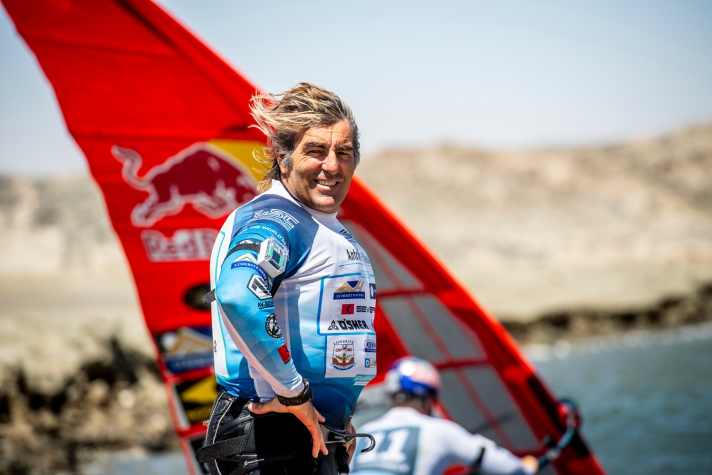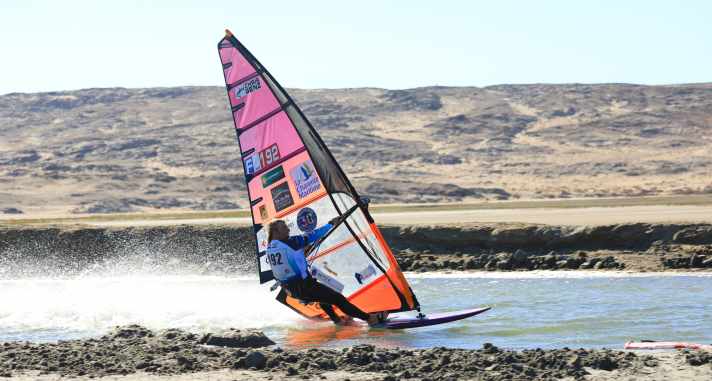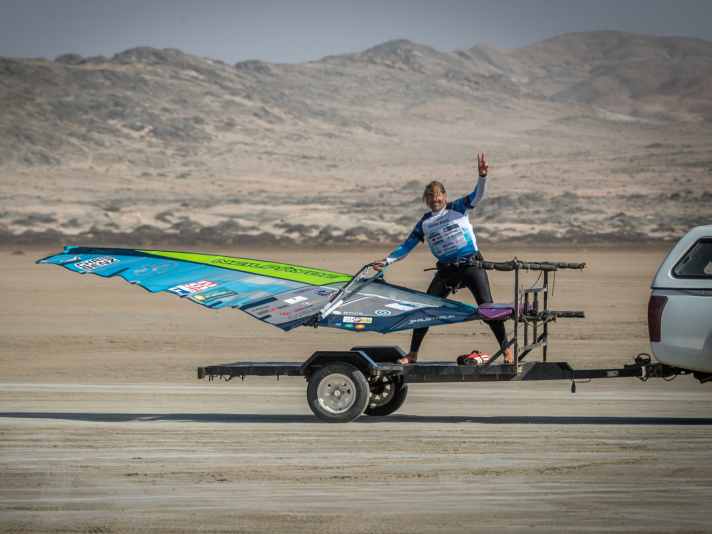Speed surfing: "The ultimate goal is 100 km/h" - Interview with Antoine Albeau
Manuel Vogel
· 19.02.2025






Every year in late autumn, the organisers of the Lüderitz Speed Challenge dig a channel a few metres wide in the lagoon of Lüderitz/Namibia - one of the windiest places in the world at this time of year. In 2015, Antoine Albeau set a world record in speed surfing here with 53.27 knots (98.66 km/h) and has since watched from afar as the competition bites its teeth out year after year.
Antoine, it seems that you have a pretty good deal with the wind god. Over the last few years, you have often skipped the Lüderitz Speed Challenge and seen from afar that the conditions were not suitable for setting a record and that your competitors were chipping away at your record. You returned in November 2024 - and Lüderitz delivered.
It's not quite like that, I was also in Lüderitz in 2023. But before that - you're right - I wasn't there for many years because I was still active in the PWA World Cup and there were overlaps. And if you want to come to Lüderitz, you have to be there for the whole time, i.e. a month. Just popping in for a fortnight doesn't work. If you miss the best days, you're annoyed and apart from that, it's always a big investment.
Speed surfing is a very special discipline. Do you prepare specifically for an event like the Lüderitz Speed Challenge? After all, record conditions can occur right at the start of the event.
You can't go to the canal before then because there's still construction going on. But of course I can train in the south of France, for example in La Palme (Speedspot near Leucate, the ed.). The problem is that they usually use different equipment there. In Namibia, we were able to train at Diaz Point a few days before the event, but of course it's not the same because the channel is very special.

What does a typical material contingent for Lüderitz look like?
I usually use two sail sizes - 5.3 and 5.7 square metres. I also had a 4.9 with me, but I didn't use it. I also have two speedboards, which are around 40 centimetres wide. I have tried and tested shapes from previous years.
What was the reason that the record was broken in 2024? Was it just the wind strength? Or were there other factors at play?
The wind conditions are of course the most important factor. The strength of the wind is important here; wind speeds of more than 45 knots are ideal. Just as important, however, is the angle at which the wind blows across the channel; a few degrees of deviation make a huge difference. And of course you need to be ready and have your equipment perfectly adjusted. For a record to be possible, all these factors have to come together.
In the past, participants were not always 100 per cent satisfied with the channel. How was it this year?
The channel was already pretty good, but of course there are always things that could be better. It's all about how the windward edge of the channel is designed so that the wind arrives evenly and there are no chops. The first part of the channel was nice and smooth this time, but after that it became increasingly choppy.
To what extent can you help shape the channel?
We're already swinging the shovel! Of course, we give our input and try to make minor adjustments ourselves on site, for example when it comes to optimising the position of the sandbags on the windward edge and so on.

The start is always described as tricky. What is important here?
You have to jump on and start gliding immediately, which is not so easy on a 40 centimetre narrow board (laughs). Right at the beginning of the start box it's still deep enough, but if you take too long to get into the straps, you can ruin your fin because it quickly becomes flat again. It's about getting up to speed straight away, because when you turn round the corner and the measurement starts, you have to be close to maximum speed if you want to set a record. On my best runs, I had around 50 or 51 knots on the speedometer just after the bend. I usually reached my highest speed 50 to 100 metres after the start line.
On the day of your world record, you had a few runs over 52 and even 53 knots. Do you realise when you cross the finish line that it was a really good run, or is the subjective feeling of speed on the water sometimes deceptive?
Going from an average speed of 52 knots to 53 may not sound like much, but it makes a huge difference for us. If you want to average 53 knots over 500 metres, you need top speeds of 55 knots in the gusts. The accelerations are of course very noticeable and fuelled the hope that the average speed was also high enough.
At this point, you will find external content that complements the article. You can display and hide it with a click.
How risky is the whole thing?
There is always a certain risk of crashing. Our fin profiles are stable up to around 50 or 51 knots, above that they can sometimes draw air and you can get a spinout. You have to realise that the channel where we are sailing is only about 35 centimetres deep. Two metres off the racing line, it's maybe another 25 centimetres. If you hit it at 100 kilometres, it's no fun. Last year I made a mistake, touched the side barrier once, crashed and broke two ribs. This year, a gust at the end of the course pushed me too far downwind, which meant I didn't have enough space to slow down in the run-out. I crashed into a pile of sand on the leeward side of the run-out zone. The bow was stuck half a metre deep in the sand, the broken tail and I luckily flew over the pile of sand.
The ultimate goal of every speed surfer is to break the 100 km/h mark over 500 metres. What does it take?
100 km/h, which is pretty much exactly 54 knots on average. My GPS data shows that I once had runs where I raced down the first half at 54.5 knots, while on other runs it was the second half. That proves it: If you get the magic run and everything fits, then 100 km/h is absolutely possible, even with the current equipment.
Are you going to wait a few more years or will you start again in 2025?
I am planning to come to the Lüderitz Speed Challenge 2025. Of course, it's always a question of budget, you have to find an external sponsor to finance it. The whole event, including travelling, the entry fee, accommodation and everything else, can easily cost 15,000 euros.

For the last 20 years, you get the feeling that speed records are almost exclusively dependent on the wind. Is there too little innovation in the material?
Yes and no. In 2015, we needed around 45 knots of wind for 50 knots of speed. In 2025, we can reach 50 knots at a wind speed of 35 knots - that's a huge improvement, which is mainly due to the improved aerodynamics of the sails. If you strap our current speed sail to runners today and sail across a frozen lake, you can reach over 100 km/h - so the sails could be faster. Little has been done with the boards for a long time, the resistance on the water is currently the limiting factor. My hopes are pinned on the "Zephyr Project", which has now got going again thanks to two sponsors. Here we can use know-how from aircraft construction at Airbus and draw on corresponding calculations and modelling. We are testing sails and wetsuits in the wind tunnel and I hope that there will also be a step forward in the boards in the near future.
Can you reveal any details about this?
Not yet (laughs). Just this much: the underwater hulls of the new boards look completely different to those of classic speedboards, with the aim of minimising drag. The aim must be to reach a speed of 50 knots at a wind speed of 30 to 35 knots. A first prototype is already finished, but I haven't let the cat out of the bag yet. My hope is that I can now do some test sessions in the south of France in winter - without anyone seeing me with it (laughs).

